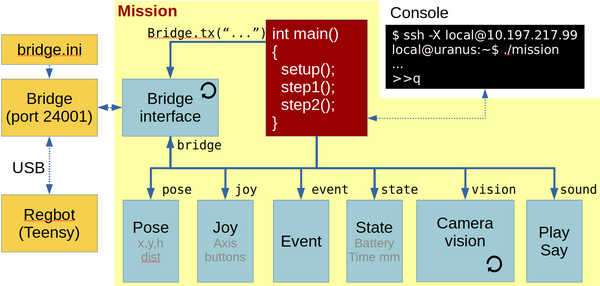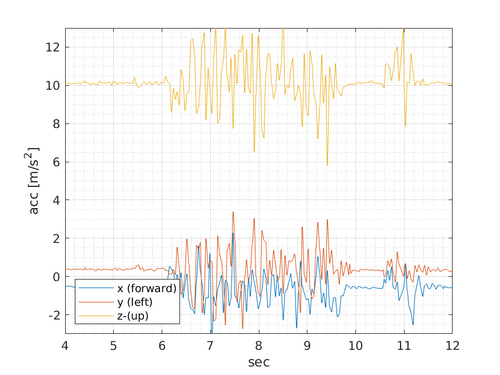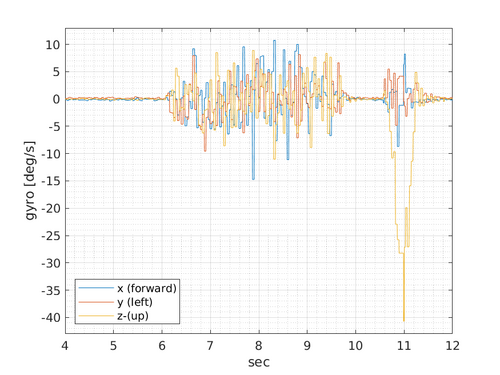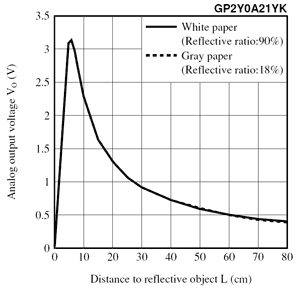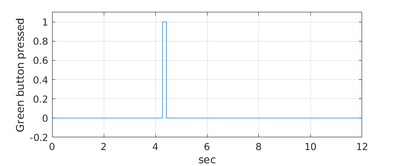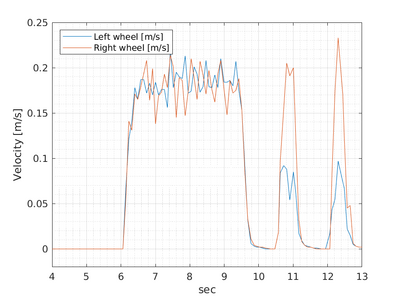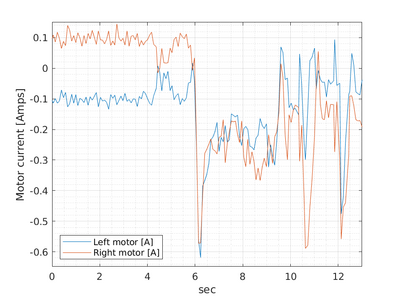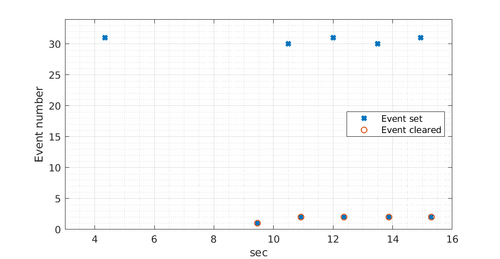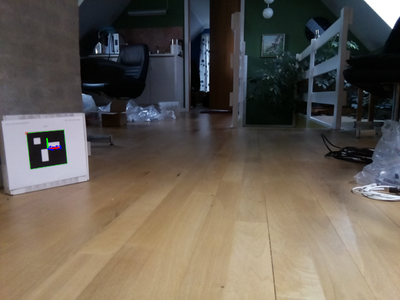Robobot mission
(→Software documentation (doxygen)) |
(→Bridge) |
||
| Line 249: | Line 249: | ||
Line 290 The thresholded image is then further filtered. | Line 290 The thresholded image is then further filtered. | ||
| − | |||
| − | |||
| − | |||
| − | |||
| − | |||
| − | |||
| − | |||
| − | |||
| − | |||
| − | |||
== Data elements == | == Data elements == | ||
Revision as of 13:30, 2 February 2023
Back to robobot
Contents |
Robobot mission software
NB! not valid for the 2023 version of the software.
This figure shows the mission functional blocks. The primary connection is to the robobot_bridge, through which the robot is controlled. The red block is the main part where the behaviour is controlled. Data elements are available in the bottom row of boxes. A camera block is available, where image processing is assumed to happen. Some vision example code is included as inspiration.
The blocks marked with a circle arrow are running in a thread to handle incoming data (from bridge or camera).
The mission application executable is in /home/local/mission/build:
local@Oscar:~ $ cd mission/build local@Oscar:~/mission/build $ ./mission Received, but not used: # Welcome to robot bridge (HAL) - send 'help' for more info Received, but not used: bridge 1 crc mod99 # Video device 0: width=1280, height=720, format=MJPG, FPS=25 # Vision::setup: Starting image capture loop # Setup finished OK
When the application starts, the welcome message is ignored (Received, but not used). It opens the camera and displays the used image size (1280 x 720) and format. And the setup is finished.
Main
The main mission program example program is like this:
1 int main(int argc, char **argv)
2 {
3 if (setup(argc, argv))
4 { // start mission
5 std::cout << "# Robobot mission starting ...\n";
6 step1();
7 step2();
8 std::cout << "# Robobot mission finished ...\n";
9 // remember to close camera
10 vision.stop();
11 sound.say("I am finished..", 0.2);
12 while (sound.isSaying())
13 sleep(1);
14 bridge.tx("regbot mute 1\n");
15 }
16 return 0;
17 }
A C++ program starts at the main(..) function. First, the interfaces and data sources need to be set up in line 3; if setup fails, the program terminates. Line 5 is just a print to the console. Lines 6 and 7 are the two mission parts used in this example. Then there is just cleanup left. Line 14 shows the way to send data to the Regbot through the Bridge. "Bridge.tx()" is the function call to transmit data to the bridge. When the send text starts with "regbot" the rest is send to the Regbot by the bridge, as "regbot" is a data source name.
Mission step
The first mission step in this example is:
1 void step1()
2 {
3 sound.say(". Step one.", 0.3);
4 // remove old mission
5 bridge.tx("regbot mclear\n");
6 // clear events received from last mission
7 event.clearEvents();
8 // add mission lines
9 bridge.tx("regbot madd vel=0.2:time=1\n");
10 bridge.tx("regbot madd tr=0.1:time=1,turn=-90\n");
11 bridge.tx("regbot madd :time=1\n");
12 // start this mission
13 bridge.tx("regbot start\n");
14 // wait until finished
15 //
16 cout << "Waiting for step 1 to finish (event 0 is send, when mission is finished)\n";
17 event.waitForEvent(0);
18 // sound.say(". Step one finished.");
19 }
Line 3 calls a "sound" function called "sound.say("string", volume)"; the function converts the text to sound (in the English language) and plays that sound file (aa.wav).
Line 5 sends a message to the Regbot to clear any old mission stored (this will also stop the active control of the robot wheels if a mission is running)
Line 7 clears events. Events can be generated in any mission line (with number 1 to 30) and is automatically generated at the start (event 33) and stop (event 0) of a Regbot mission.
Line 9 to 11 adds new mission lines, the first part "regbot" tells the bridge that it is for the Regbot, and the second part "madd" tells the Regbot that this is a line to add. The rest of the string is decoded as a mission line.
In case of syntax error, a message is sent back from the Regbot, like:
regbot:# UMissionThread::addLine syntax error thread 1 line 0: failed parameter at 2:time=1
The first part "regbot:" says that it is from the Regbot, the rest of the line says that in "thread 1 line 0", there is an error. The offending part is shown "2:time=1", here the error was that the velocity part "vel=0.2" was written as "vel=0,2", and the comma is used as a separation of commands.
Line 13 tells the Regbot to start the just downloaded mission lines.
Line 17 waits for event 0 to happen, indicating "end of the mission".
Setup
The setup function called all data modules in turn. The data modules will subscribe to the relevant data from the bridge and the Regbot.
The bridge module that receives the returned data from the bridge will, in turn, ask all the data modules if they handle this message type. The code is in line 40 in the "bridge.cpp" file.
Vision
The vision setup opens the camera with these lines in file "vision.cpp"
// line 64 ff
// prepare to open the camera
int deviceID = dev; // 0 = open default camera
int apiID = cv::CAP_V4L2; // Video for Linux version 2
// open selected camera using selected API
cap.open(deviceID, apiID);
// check if we succeeded
camIsOpen = cap.isOpened();
if (not camIsOpen)
{
cerr << "ERROR! Unable to open camera\n";
}
Capture image thread
If opening is successful, then a thread is started (line 102):
// start thread to keep buffer empty
printf("# Vision::setup: Starting image capture loop\n");
listener = new thread(startloop, this);
The "startLoop" calls "loop" (line 136ff)
void UVision::loop() {
while (camIsOpen and not terminate)
{ // keep framebuffer empty
if (useFrame)
{ // grab and decode next image
cap.read(frame);
// mark as available
gotFrame = not frame.empty();
useFrame = not gotFrame;
}
else
// just grab the image - mark it as used
cap.grab();
frameSerial++;
}
}
As long as no one has set the boolean "useFrame=true", the loop will just call "cap.grab()" to keep the frame buffer empty. When "useFrame" is true, the next image will be saved in the "frame" image buffer.
The function "getNewestFrame()" will tell the loop to capture an image and then wait until the image is in the frame buffer.
Process image
The function "processImage()" is intended to be called from one of the mission steps, and this example is overly complicated, but some of the important lines are shown here:
170 bool UVision::processImage(float seconds)
{ // process images in 'seconds' seconds
...
182 getNewestFrame();
if (gotFrame)
{ // save the image - with a number
const int MSL = 100;
char s[MSL];
snprintf(s, MSL, "sandberg_%03d.png", n);
t3.now();
200 cv::imwrite(s, frame);
printf("Image save took %.3f sec\n", t3.getTimePassed());
}
...
ballBoundingBox.clear();
207 terminate = doFindBall();
...
return terminate or not camIsOpen;
}
Line 182 requests a fresh image, "gotFrame" is true if successful.
Line 200 saves the image to a file (n is the frame number).
Line 207 calls an image analysis function and returns true if a ball is found.
Find ball OpenCv example
To illustrate some of the OpenCV calls, the example function "doFineBall" highlights are:
bool UVision::doFindBall()
{ // process pipeline to find
// bounding boxes of balls with matched colour
242 cv::Mat yuv;
244 cv::cvtColor(frame, yuv, cv::COLOR_BGR2YUV);
int h = yuv.rows;
int w = yuv.cols;
247 cv::imwrite("yuv_balls_01.png", yuv);
// color for filter
251 cv::Vec3b yuvOrange = cv::Vec3b(128,88,187);
252 cv::Mat gray1(h,w, CV_8UC1);
// test all pixels
for (int r = 0; r < h; r++)
{ // get pointers to pixel-row for destination image
256 uchar * pOra = (uchar*) gray1.ptr(r); // gray
for (int c = 0; c < w; c++)
{ // go through all pixels in this row
int d;
260 cv::Vec3b p = yuv.at<cv::Vec3b>(r,c);
261 d = uvDistance(p, yuvOrange);
262 *pOra = 255 - d;
pOra++; // increase to next destination pixel
}
}
// do static threshold at value 230, max is 255, and mode is 3 (zero all pixels below threshold)
cv::Mat gray2;
285 cv::threshold(gray1, gray2, 230, 255, 3);
// remove small items with a erode/delate
// last parameter is iterations and could be increased
cv::Mat gray3, gray4;
290 cv::erode(gray2, gray3, cv::Mat(), cv::Point(-1,-1), 1);
cv::dilate(gray3, gray4, cv::Mat(), cv::Point(-1,-1), 1);
Line 242 creates an OpenCV image handle called "yuv"
Line 244 converts the fresh image to be in YUV colour coding; this has isolated brightness to the channel Y and the colour to two dimensions U and V.
Line 247 Saves the YUV image to a file (as if it were a BGR image), this is to be used to find the colour (Y and V) of the ball to be detected.
Line 251 Inserts the found colour (found in an image application from the "yuv_balls_01.png" file)
Line 252 Creates a gray-scale image of the same size as the original image (gray values from 0 to 255, CV_8UC1 is 8-bit unsigned with one channel).
Line 256 Gets a pointer to the first pixel in the grayscale image (to write the filtered image)
Line 260 Gets the YUV pixel at position (r,c) as a vector with 3 byte sized values (cv:Vec3b).
Line 261 Gets the colour difference between the selected U,V value (line 251) and the UV value of this pixel, by just adding the distance in the U direction to the distance in the Y direction, as:
225 int UVision::uvDistance(cv::Vec3b pix, cv::Vec3b col)
{ /// format is Y,V,U and Y is not used
int d = abs(pix[1] - col[1]) + abs(pix[2] - col[2]);
The output is limited to maximum 255.
Line 262 Writes the result to the grayscale image so that a small distance is white (255).
Line 285 Then thresholds the image to a new image called "gray2". Values above 230 (no more than 25 values from the selected colour) are likely to be the from the ball colour we are looking for.
Line 290 The thresholded image is then further filtered.
Data elements
This is a list of the features of each of the data elements.
IMU
The IMU is an MPU-9150 chip from InvenSense, that provide accelerometer and gyro signals on all 3 axes.
Accelerometer data. The z-axis shows the gravity acceleration, and when the robot starts driving after 6 seconds, there is clearly some bumping, that is seen as noise. The robot holds a pause at about 10 to 10.5 seconds and then turns a bit. The values on the x-axis (forward) ought to show some lateral acceleration, but it is hard to see in the noise.
Gyro data. While driving forward (from 6 to 10 seconds) there is a significant amount of noise. The robot holds a pause at about 10 to 10.5 seconds and then turns a bit. The turning (from 10.5 to 11.5 seconds) is clearly visible on the gyro z-axes.
The data is accessible in the mission code as:
bridge->imu->acc[0] Acceleration in x-axes (forward) [m/s^2] bridge->imu->acc[1] y-axis (left) bridge->imu->acc[2] z-axes (up) bridge->imu->gyro[0] Rotation velocity around x-axes [degree/sec] bridge->imu->gyro[1] y-axis bridge->imu->gyro[2] z-axes
There is further a turn rate function (vector sum of all three gyro axes):
bridge->imu->turnrate()
There is no calculated nor calibrated scale not offset on the accelerometer reading.
The gyro offset can be calibrated using the REGBOT GUI (IMU tab).
IR-dist
There are two IR sharp sensors type GP2Y0A21, a 10-80cm sensor.
The raw response from the sensor is approximate as shown here
The part from about 8-10cm is converted to a distance in meter using the calibration points in the REGBOT GUI.
A data example is shown above in the logfiles section.
The data is accessible using
bridge->irdist->dist[0] is distance sensor 1 [m] bridge->irdist->dist[1] is distance sensor 2 [m]
Pose
The robot pose includes position, orientation and tilt and is accessed as
bridge->pose->x distance in x-direction (forward) sinse start of mission. bridge->pose->y y-distance bridge->pose->h heading in radians, zero is aligned with x-axes, positive is counter clockwise bridge->pose->tilt tilt is rotation angle around the y-axis (used for REGBOT balance) (using a complementary filter (acc and gyro). bridge->pose->dist distance driven since start of mission [m].
The data from the same mission as above looks like.
The first plot shows that the robot moves 0.6m forward (y=0 and h=0) starting at 6 seconds and stops at 10 seconds - to take an image. After this, it takes a number of turns (about 20 degrees with a turning radius of about 0.2m) with a stop for about a second (looking for an ArUco code in the image).
After 18 seconds and the heading is about 0.9 radians, and an ArUco-code is visible. Thien the robot advances to the position of the code (in a turn-drive-turn manoeuver).
The second plot shows the position of the robot. First about 0.6m forward, then turning in small steps until the marker is seen, from there on a turn with a smaller turn radius, a straight part and a final turn to face the marker.
Calibration of the odometry is the wheel-base (distance between driving wheels) and the wheel radius. These setting must be inserted in the REGBOT GUI (robot tab).
Joy
The joystick data is available from the bridge.
The following data is available
bridge->joy->axes[0] (left hand left-right axes) ... bridge->joy->axis[7] (digital up-down axes)
For the other axes see Robobot_bridge#Gamepad. The value is a signed 16-bit value (-32767 to 32766) for the axes.
bridge->joy->button[0] Green button ... bridge->joy->button[10] Right knob
For the other buttons see Robobot_bridge#Gamepad. The value is 0 (not pressed) and 1 (pressed).
There is further a flag for manual override by the gamepad
bridge->joy->manual
With true or false value (true means gamepad control)
The mission from the other plots gets started with a press on the green button about 4 seconds after the start of the mission application. (the robot then further awaits the distance of IR sensor 2 is below 0.3m before starting to move).
Motor
The motor interface gives the (estimated) velocity of the two driving wheels.
bridge->motor->velocity[0] Velocity of the left wheel in m/s bridge->motor->velocity[1] Velocity of right wheel
There is further access to the motor current.
bridge->motor->current[0] Current of the left motor in Amps bridge->motor->current[1] Current of right motor
An example from the mission used earlier is shown. The left plot shows the estimated velocity, where the velocity starts after 6 seconds at about 0.2 m/s and going back to zero at about 10 seconds, and after that starts turning at 10.5 and 12 seconds - the right wheel drives faster. It is visible that there is significant noise on the velocity estimate.
The right current plot shows that the control is active (but not moving) with a current about 100mA. After 6 seconds there is a current peak to about 600mA that starts the motors and then drives with a current of about 250mA. Again after 10.5 and 12 seconds, there is a start-current peak.
Info
The info block holds some static data, but also data from the heartbeat message - the only part that can be logged).
From heartbeat message
bridge->info->regbotTime Time from REGBOT in seconds since "start" message bridge->info->batteryVoltage In Volts bridge->info->missionLineNum Line number in thread (the last linenumber started) bridge->info->missionThread The thread number (where the line number is valid)
Basic robot info that is updated at least once at the start of the mission
bridge->info->robotId The REGBOT robot ID number (decides the name) bridge->info->odoWheelBase The (calibrated) distance between the driving wheels (reproted by REGBOT), bridge->info->gear The gear ratio (reported by REGBOT) bridge->info->pulsPerRev The number of ticks in one motor rotation (reported from REGBOT) bridge->info->odoWheelRadius[0] The radius of left wheel in meters (reported from REGBOT) bridge->info->odoWheelRadius[1] The radius of right wheel in meters bridge->info->robotname A C-string with the robot name bridge->info->msgCnt1sec Number of messages received from bridge in one second.
There is further a function that reports if communication with the robot is OK.
bridge->info->isHeartbeatOK()
Returns true if a heartbeat message is reported within the last 2 seconds. It should be reported about every 0.5 seconds.
Event
Holds all 34 event flags.
To test if an event has occurred use this function
bridge->event->isEventSet(X); Where X is the event number (between 0 and 33)
This call to isEventSet(x) also clears the event flag, so that the flag is ready to be set again. And thus can be used to clear the event.
The raw event flag can be accessed in the event array:
bridge->event->eventFlags[X]; Where X is a number from 0 to 33.
Two flags have a special meaning: Event 0 stops the mission in REGBOT (and terminates the mission app). To trigger a stop event use the call:
bridge->stop();
To start a mission send the command "start" to the robot:
bridge->send("start\n");
This will trigger an event 33.
Events 30 and 31 are used in the mission app to swap between the two buffer threads and should not be used for anything else.
Events 1 to 29 can be used in mission lines to track progress.
The logfile has a list of when each of them has been set or cleared.
This plot shows the events related to the mission also used above. The first event is 31 at about 5 seconds, this will activate the first thread with drive mission lines. When the drive has reached the last line is sends an event 1 (about 9.5 seconds), this event is regularly tested by the mission app and is cleared almost immediately. It triggers a pause where an image is taken and analyzed.
After a second, the conclusion is clear and new mission lines (called a mission snipped) are sent to the REGBOT and activated with an event 30 (to the REGBOT). When the snippet is finished an event 2 is sent (from the REGBOT). This again triggers new actions in the mission app.
Edge
The edge sensor (also called line sensor) is primarily used by the REGBOT when driving on a line, but some information is available from the edge sensor:
bridge->edge->edgeValidLeft bridge->edge->edgeValidRight bridge->edge->edgeCrossingBlack bridge->edge->edgeCrossingWhite
These (bool variables) will be set (to 1 (true) or 0 (false)) as detected by the line sensor but is updated at a rather slow pace (30-50ms). it is thus likely that a crossing line can be missed (the detection on REGBOT is tested evert 1ms).
'EdgeCrossingBlack' crossing a black line is never really tested, and should not be considered usable. The two variables 'edgeValidLeft' and 'edgeValidRight' are always true and false at the same time (a legacy feature).
Mission
The mission block has access to all the other elements and controls the performance of the robot.
The mission is controlled by two states
- a mission segment - that is intended to do a part of a mission
- a mission state - that control the mission snippets that are sent to the REGBOT for execution.
The mission used in the plots above is divided into two mission segments. The first segment waits for a start signal and drives the first straight part. The second segment do the rest - look for Aruco code and turns a bit if not found and drive to the ArUco marker if found.
The following plot shows the timing of these two states, the mission segment and the mission state.
The mission segment (red curve) start by mission segment 1 after about 6 seconds and switch to mission segment 2 after about 9.5 seconds. The mission state (blue curve) starts at state 0, then fast state 10 and 11, stay at state 11 for a long time (while driving) and ends at state 999 (over the top). Mission segment switches between states 10, 11, 20 and 21 a number of times (turning), and when the marker is found state 30 and 31.
Mission segment loop
The mission state is handled by a function called
runMission()
In this loop, there is also a check for manual or automatic operation and some odd gamepad reactions.
The mission segment loop constantly calls the mission code with the mission state as a parameter.
The mission segment loop code is described here in more detail.
Mission segment code
mission1(state)
- First segment with movement (0.6m at a velocity of 0.2m/s) and is using a gamepad button, event, sound and display on the o-led display.
mission2(state)
- Second segment that waits for the robot to stand still, take an image and do ArUco code analysis. Depending on the code analysis either the robot turns or moves to face the marker. It is using a library to calculate a manoeuvre (a turn, a straight part and an end turn to get to the destination.
mission3(state) ...
- Empty functions that just return true (finished).
The mission code is described here in more detail.
Camera
Camera calibration
To use the camera to determine distances, calibration is needed.
A rough calibration is used that, in most cases, is sufficient.
The camera calibration consists of a camera matrix and a lens distortion vector. This is set in the camera class definition in the file 'ucamera.h':
/** camera matrix is a 3x3 matrix (raspberry PI typical values)
* pix ---1---- ---2--- ---3--- -3D-
* 1 (x) 980 0 640 (X)
* 2 (y) 0 980 480 (Y)
* 3 (w) 0 0 1 (Z)
* where [1,1] and [2,2] is focal length,
* and [1,3] is half width center column (assuming image is 1280 pixels wide)
* and [2,3] is half height center row (assuming image is 960 pixels high)
* [X,Y,Z] is 3D position (in camera coordinated (X=right, Y=down, Z=front),
* [x,y,w] is pixel position for 3D position, when normalized, so that w=1
*/
const cv::Mat cameraMatrix = (cv::Mat_<double>(3,3) <<
980, 0, 640,
0, 980, 480,
0, 0, 1);
/**
* camera radial distortion vector
* 1 (k1) 0.14738
* 2 (k2) 0.0117267
* 3 (p1) 0
* 4 (p2) 0
* 5 (k3) -0.14143
* where k1, k2 and k3 is radial distortion params
* and p1, p2 are tangential distortion
* see https://docs.opencv.org/2.4/doc/tutorials/calib3d/camera_calibration/camera_calibration.html
* */
const cv::Mat distortionCoefficients = (cv::Mat_<double>(1,5) <<
0.14738,
0.0117267,
0,
0,
-0.14143);
The matrix 'cameraMatrix' holds the focal length set to approximately 980 pixels (in this image resolution) and the optical centre of the image set to the geometric centre of the image frame.
The vector 'distortionCoefficients' is set to some values estimated in an earlier student project.
Camera coordinate conversion matrix
The camera is placed on the robot at some distance from the origo of the robot coordinate system.
The default position and tilt is set in the class definition (uvision.h):
const float camPos[3] = {0.13,-0.02, 0.23}; // in meters
const float camTilt = 22 * M_PI / 180; // in radians
cv::Mat1f camToRobot;
And the conversion matrix from camera coordinates to robot coordinates are added in uvision.cpp setup()
float st = sin(camTilt);
float ct = cos(camTilt);
camToRobot = (cv::Mat1f(4,4) << ct, 0.f, st, camPos[0],
0.f , 1.f, 0.f , camPos[1],
-st, 0.f, ct, camPos[2],
0.f , 0.f, 0.f , 1.f);
This coordinate conversion matrix is used to find the position of an object (e.g. a ball) once the ball's position is found in camera coordinates.
ArUco
OpenCV has a library function to detect ArUco codes and estimate their position in camera coordinates.
This requires that the camera is calibrated with a camera matrix and a lens distortion vector. These are implemented in the camera class (UCamera.h).
The coordinate system used for detection is camera coordinates: (x,y,z) where x is to the right, y is down and z is forward and rotation around the same axes.
An ArUco marker seen by the robot in my home domain.
Ecample code
An example code to extract the codes and save the ArUco marker position in robot coordinates are implemented as a 'ArUcoVals' class in the uaruco.h and uaruco.cpp files. The found values are stored in an array 'arucos' of class objects of type 'ArUcoVal' (also in the uaruco.h and aruco.cpp files)
The extraction is in the function
int ArUcoVals::doArUcoProcessing(cv::Mat frame, int frameNumber, UTime imTime)
{
cv::Mat frameAnn;
const float arucoSqaureDimensions = 0.100; //meters
vector<int> markerIds;
vector<vector<cv::Point2f>> markerCorners; //, rejectedcandidates;
cv::aruco::DetectorParameters parameters;
//seach DICT on docs.opencv.org
cv::Ptr < cv::aruco::Dictionary> markerDictionary = cv::aruco::getPredefinedDictionary(cv::aruco::PREDEFINED_DICTIONARY_NAME::DICT_4X4_100);
// marker position info
vector<cv::Vec3d> rotationVectors, translationVectors;
UTime t; // timing calculation (for log)
t.now(); // start timing
// clear all flags (but maintain old information)
setNewFlagToFalse();
/** Each marker has 4 marker corners into 'markerCorners' in image pixel coordinates (float x,y).
* Marker ID is the detected marker ID, a vector of integer.
* */
cv::aruco::detectMarkers(frame, markerDictionary, markerCorners, markerIds);
// marker size is same as detected markers
if (markerIds.size() > 0)
{ // there are markers in image
if (debugImages)
{ // make a copy for nice saved images
frame.copyTo(frameAnn);
cv::aruco::drawDetectedMarkers(frameAnn, markerCorners, markerIds);
}
//
cv::aruco::estimatePoseSingleMarkers(markerCorners,
arucoSqaureDimensions,
cam->cameraMatrix,
cam->distortionCoefficients,
rotationVectors,
translationVectors);
}
else
printf("# No markers found\n");
The functions 'cv::aruco::detectMarkers(...)' and 'cv::aruco::estimatePoseSingleMarkers(...)' has the functionality, but requires som data setup to function, as shown above.
All found markers are then saved and their position and orientation is converted to robot coordinates. Robot coordinates are defined as (x,y,z), where x is forward, y is left and z is up (plus orientation around the same coordinates). The reference position is the centre between the driving wheels at ground level.
Each marker is updated with this code
ArUcoVal * v = getID(i);
if (v != NULL)
{ // save marker info and do coordinate conversion for marker
v->lock.lock();
v->markerId = i;
// set time and frame-number for this detection
v->imageTime = imTime;
v->frameNumber = frameNumber;
// v->frame = frame; // might use frame.copyTo(v->frame) insted
v->rVec = rotationVectors[j];
v->tVec = translationVectors[j];
//
if (debugImages)
{ // show detected orientation in image X:red, Y:green, Z:blue.
cv::aruco::drawAxis(frameAnn, cam->cameraMatrix, cam->distortionCoefficients, v->rVec, v->tVec, 0.03f); //X:red, Y:green, Z:blue.
}
//
v->markerToRobotCoordinate(cam->cam2robot);
v->isNew = true;
v->lock.unlock();
The coordinate conversion is in the 'markerToRobotCoordinate(cv::Mat cam2robot)' function.
This function also determines if the marker is vertical or horizontal, and estimates based on this the orientation as one angle around the robot z-axis (up). This can then be used as a destination pose, using the x,y from the marker position and heading (called 'markerAngle' )
The values for the marker is protected by a resource lock, as it is generated and used by different threads.
Installation
Get software
Get the ROBOBOT software from the svn repository:
svn checkout svn://repos.gbar.dtu.dk/jcan/robobot
or just update if there already (as it is on the Raspberry Pi)
svn up
Compile
To be able to compile the demo software CMAKE needs also to use the user installed library (raspicam installed above), so add the following line to ~/.bashrc:
export CMAKE_PREFIX_PATH=/usr/local/lib
Then build Makefiles and compile:
cd ~/mission mkdir -p build cd build cmake .. make -j3
Then test-run the application:
./mission
It should print that the camera is open and the bridge is connected to the REGBOT hardware.
